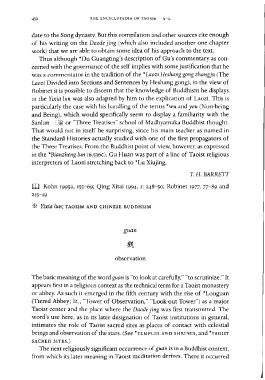Page 492 - The Encyclopedia of Taoism v1_A-L
P. 492
452 THE ENCYCLOPEDIA OF TAOISM A-L
date to the Song dynasty. But this compilation and other sources cite enough
of his writing on the Daode jing (which also included another one-chapter
work) that we are able to obtain some idea of his approach to the text.
Thus although *Du Guangting's description of Gu's commentary as con-
cerned with the governance of the self implies with some justification that he
was a commentator in the tradition of the * Laozi Heshang gong zhangju (The
Laozi Divided into Sections and Sentences by Heshang gong), in the view of
Robinet it is possible to discern that the knowledge of Buddhism he displays
in the Yixia lun was also adapted by him to the explication of Laozi. This is
particularly the case with his handling of the terms *wu and you (Non-being
and Being), which would specifically seem to display a familiarity with the
Sanlun ~ ~ or "Three Treatises" school of Madhyamaka Buddhist thought.
That would not in itself be surprising, since his main teacher as named in
the Standard Histories actually studied with one of the first propagators of
the Three Treatises. From the Buddhist point of view, however, as expressed
in the *Bianzheng lun (6.536c), Gu Huan was part of a line of Taoist religious
interpreters of Laozi stretching back to *Lu Xiujing.
T. H. BARRETT
m Kohn 1995a, 155-69; Qing Xitai 1994, 1: 248-50; Robinet 1977, 77-89 and
215-19
* Yixia lun; TAOISM AND CHINESE BUDDHISM
guan
observation
The basic meaning of the word guan is "to look at carefully," "to scrutinize." It
appears first in a religious context as the technical term for a Taoist monastery
or abbey. As such it emerged in the fifth century with the rise of *Louguan
(Tiered Abbey; lit., "Tower of Observation," "Look-out Tower") as a major
Taoist center and the place where the Daode jing was first transmitted. The
word's use here, as in its later designation of Taoist institutions in general,
intimates the role of Taoist sacred sites as places of contact with celestial
beings and observation of the stars. (See *TEMPLES AND SHRINES, and *TAOIST
SACRED SITES.)
The next religiously significant occurrence of guan is in a Buddhist context,
from which its later meaning in Taoist meditation derives. There it occurred

